Annotated Bibliography on Employee Turnover in Organizations
VerifiedAdded on 2022/10/04
|9
|2253
|28
Annotated Bibliography
AI Summary
This annotated bibliography examines the multifaceted issue of employee turnover, drawing from a range of academic sources to provide a comprehensive overview of the topic. The bibliography begins with an analysis of an article discussing employee turnover at the PVIS Company, highlighting issues such as poor management and limited growth opportunities. The expectancy theory is then explored, emphasizing the psychological rewards that influence employee behavior and the factors leading to turnover. Subsequent entries delve into the perspectives of excluded hotel employees, the motivations of millennial employees, and the impact of turnover on company performance. The bibliography also examines the effects of organizational embeddedness, high-involvement work practices, safety climate, and pay-for-performance policies on employee turnover rates. Each entry includes a summary of the source's content, its authority, intended audience, transparency, objectivity, and currency, offering a critical evaluation of the research and its relevance to the field. The sources cited include academic journals, books, and company records, providing a diverse and in-depth analysis of the key drivers and consequences of employee turnover.
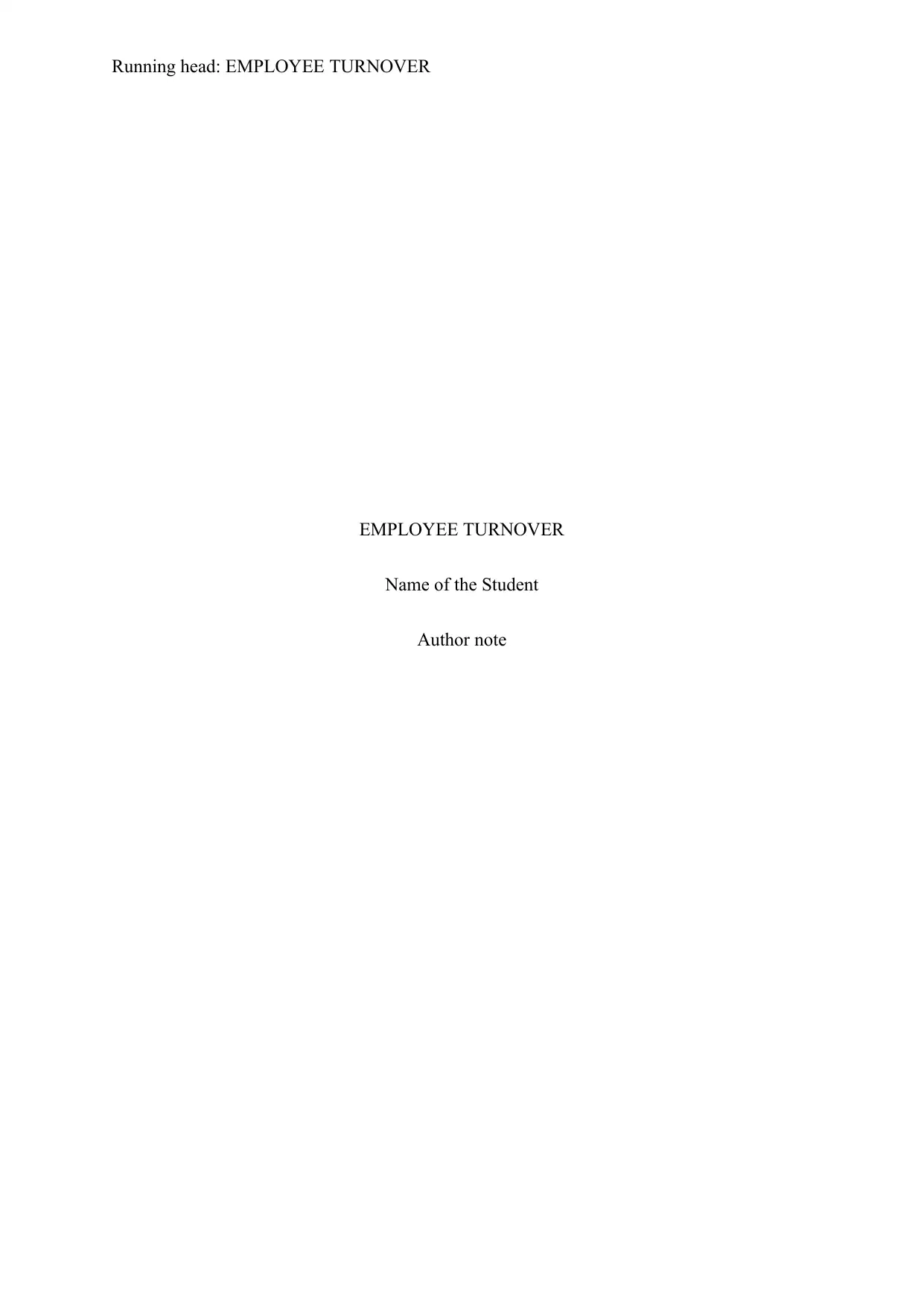
Running head: EMPLOYEE TURNOVER
EMPLOYEE TURNOVER
Name of the Student
Author note
EMPLOYEE TURNOVER
Name of the Student
Author note
Paraphrase This Document
Need a fresh take? Get an instant paraphrase of this document with our AI Paraphraser
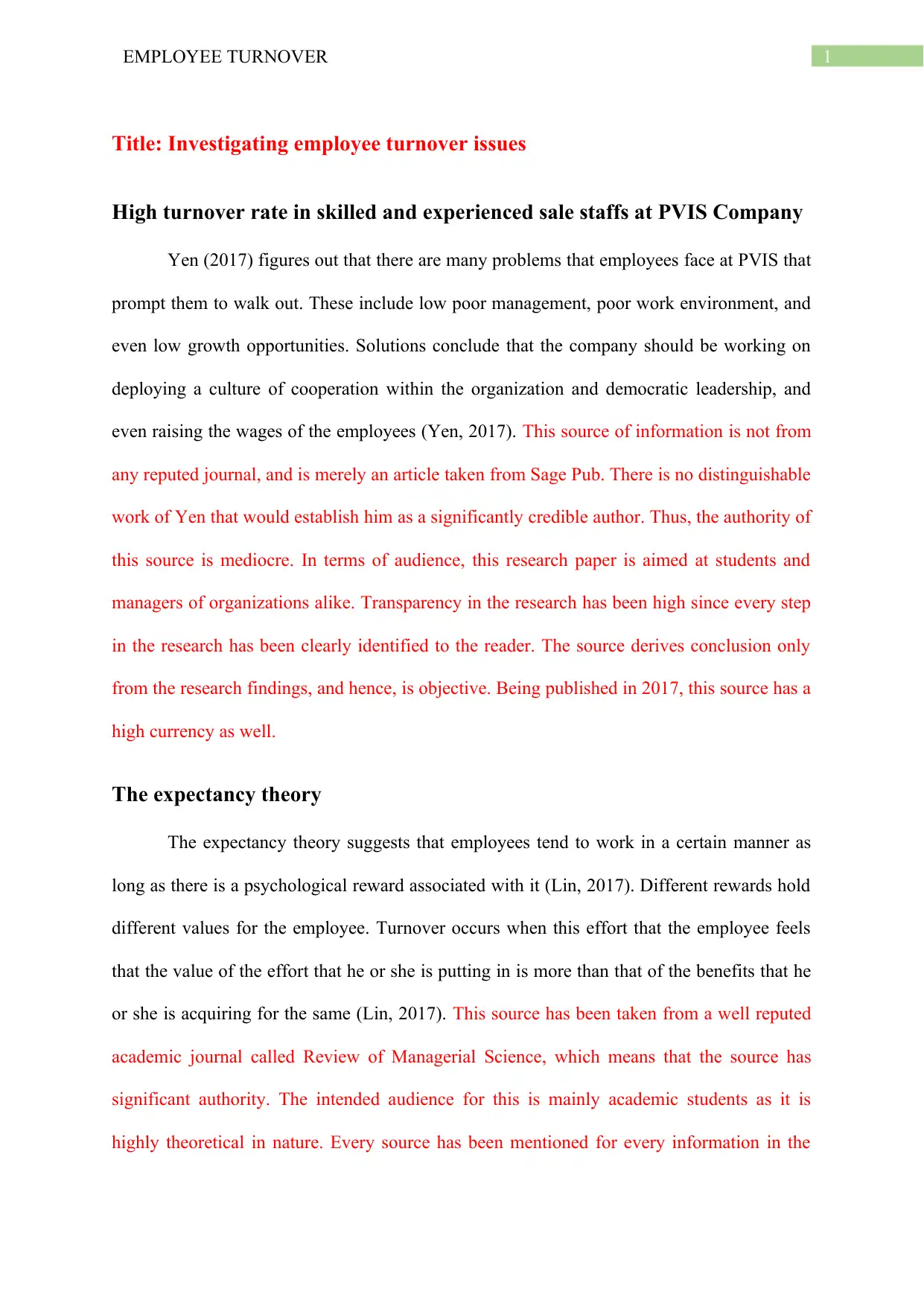
1EMPLOYEE TURNOVER
Title: Investigating employee turnover issues
High turnover rate in skilled and experienced sale staffs at PVIS Company
Yen (2017) figures out that there are many problems that employees face at PVIS that
prompt them to walk out. These include low poor management, poor work environment, and
even low growth opportunities. Solutions conclude that the company should be working on
deploying a culture of cooperation within the organization and democratic leadership, and
even raising the wages of the employees (Yen, 2017). This source of information is not from
any reputed journal, and is merely an article taken from Sage Pub. There is no distinguishable
work of Yen that would establish him as a significantly credible author. Thus, the authority of
this source is mediocre. In terms of audience, this research paper is aimed at students and
managers of organizations alike. Transparency in the research has been high since every step
in the research has been clearly identified to the reader. The source derives conclusion only
from the research findings, and hence, is objective. Being published in 2017, this source has a
high currency as well.
The expectancy theory
The expectancy theory suggests that employees tend to work in a certain manner as
long as there is a psychological reward associated with it (Lin, 2017). Different rewards hold
different values for the employee. Turnover occurs when this effort that the employee feels
that the value of the effort that he or she is putting in is more than that of the benefits that he
or she is acquiring for the same (Lin, 2017). This source has been taken from a well reputed
academic journal called Review of Managerial Science, which means that the source has
significant authority. The intended audience for this is mainly academic students as it is
highly theoretical in nature. Every source has been mentioned for every information in the
Title: Investigating employee turnover issues
High turnover rate in skilled and experienced sale staffs at PVIS Company
Yen (2017) figures out that there are many problems that employees face at PVIS that
prompt them to walk out. These include low poor management, poor work environment, and
even low growth opportunities. Solutions conclude that the company should be working on
deploying a culture of cooperation within the organization and democratic leadership, and
even raising the wages of the employees (Yen, 2017). This source of information is not from
any reputed journal, and is merely an article taken from Sage Pub. There is no distinguishable
work of Yen that would establish him as a significantly credible author. Thus, the authority of
this source is mediocre. In terms of audience, this research paper is aimed at students and
managers of organizations alike. Transparency in the research has been high since every step
in the research has been clearly identified to the reader. The source derives conclusion only
from the research findings, and hence, is objective. Being published in 2017, this source has a
high currency as well.
The expectancy theory
The expectancy theory suggests that employees tend to work in a certain manner as
long as there is a psychological reward associated with it (Lin, 2017). Different rewards hold
different values for the employee. Turnover occurs when this effort that the employee feels
that the value of the effort that he or she is putting in is more than that of the benefits that he
or she is acquiring for the same (Lin, 2017). This source has been taken from a well reputed
academic journal called Review of Managerial Science, which means that the source has
significant authority. The intended audience for this is mainly academic students as it is
highly theoretical in nature. Every source has been mentioned for every information in the
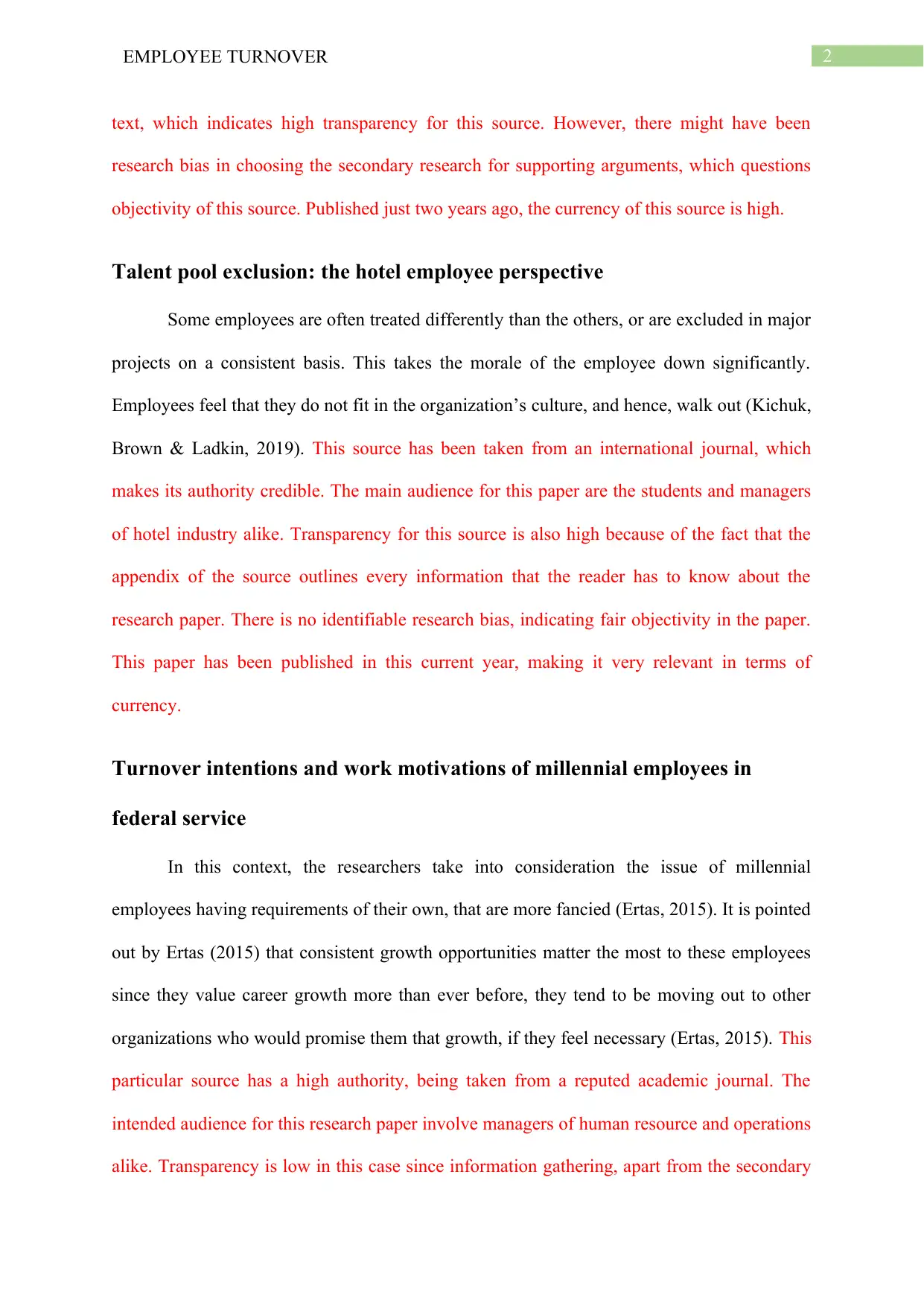
2EMPLOYEE TURNOVER
text, which indicates high transparency for this source. However, there might have been
research bias in choosing the secondary research for supporting arguments, which questions
objectivity of this source. Published just two years ago, the currency of this source is high.
Talent pool exclusion: the hotel employee perspective
Some employees are often treated differently than the others, or are excluded in major
projects on a consistent basis. This takes the morale of the employee down significantly.
Employees feel that they do not fit in the organization’s culture, and hence, walk out (Kichuk,
Brown & Ladkin, 2019). This source has been taken from an international journal, which
makes its authority credible. The main audience for this paper are the students and managers
of hotel industry alike. Transparency for this source is also high because of the fact that the
appendix of the source outlines every information that the reader has to know about the
research paper. There is no identifiable research bias, indicating fair objectivity in the paper.
This paper has been published in this current year, making it very relevant in terms of
currency.
Turnover intentions and work motivations of millennial employees in
federal service
In this context, the researchers take into consideration the issue of millennial
employees having requirements of their own, that are more fancied (Ertas, 2015). It is pointed
out by Ertas (2015) that consistent growth opportunities matter the most to these employees
since they value career growth more than ever before, they tend to be moving out to other
organizations who would promise them that growth, if they feel necessary (Ertas, 2015). This
particular source has a high authority, being taken from a reputed academic journal. The
intended audience for this research paper involve managers of human resource and operations
alike. Transparency is low in this case since information gathering, apart from the secondary
text, which indicates high transparency for this source. However, there might have been
research bias in choosing the secondary research for supporting arguments, which questions
objectivity of this source. Published just two years ago, the currency of this source is high.
Talent pool exclusion: the hotel employee perspective
Some employees are often treated differently than the others, or are excluded in major
projects on a consistent basis. This takes the morale of the employee down significantly.
Employees feel that they do not fit in the organization’s culture, and hence, walk out (Kichuk,
Brown & Ladkin, 2019). This source has been taken from an international journal, which
makes its authority credible. The main audience for this paper are the students and managers
of hotel industry alike. Transparency for this source is also high because of the fact that the
appendix of the source outlines every information that the reader has to know about the
research paper. There is no identifiable research bias, indicating fair objectivity in the paper.
This paper has been published in this current year, making it very relevant in terms of
currency.
Turnover intentions and work motivations of millennial employees in
federal service
In this context, the researchers take into consideration the issue of millennial
employees having requirements of their own, that are more fancied (Ertas, 2015). It is pointed
out by Ertas (2015) that consistent growth opportunities matter the most to these employees
since they value career growth more than ever before, they tend to be moving out to other
organizations who would promise them that growth, if they feel necessary (Ertas, 2015). This
particular source has a high authority, being taken from a reputed academic journal. The
intended audience for this research paper involve managers of human resource and operations
alike. Transparency is low in this case since information gathering, apart from the secondary
⊘ This is a preview!⊘
Do you want full access?
Subscribe today to unlock all pages.

Trusted by 1+ million students worldwide
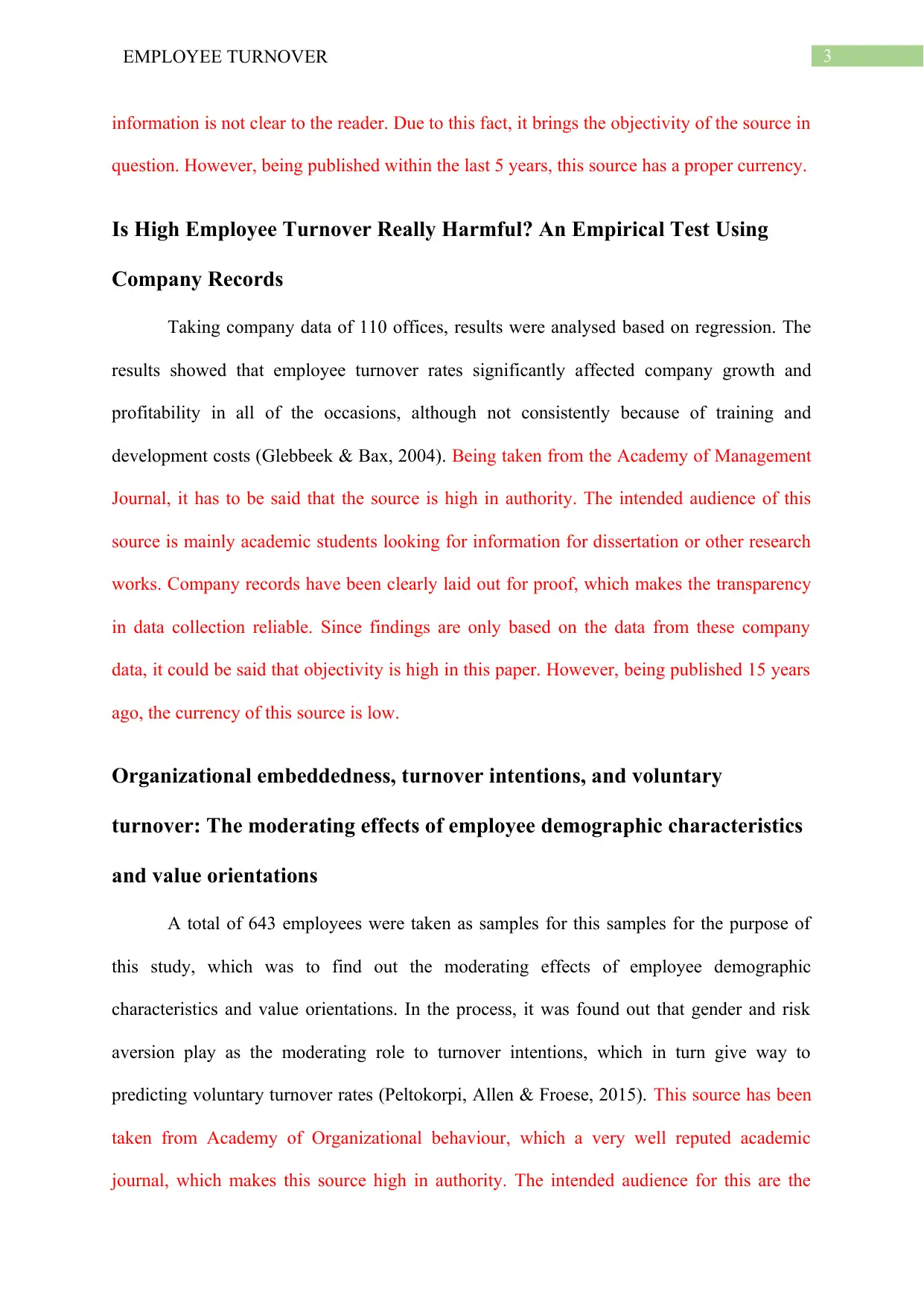
3EMPLOYEE TURNOVER
information is not clear to the reader. Due to this fact, it brings the objectivity of the source in
question. However, being published within the last 5 years, this source has a proper currency.
Is High Employee Turnover Really Harmful? An Empirical Test Using
Company Records
Taking company data of 110 offices, results were analysed based on regression. The
results showed that employee turnover rates significantly affected company growth and
profitability in all of the occasions, although not consistently because of training and
development costs (Glebbeek & Bax, 2004). Being taken from the Academy of Management
Journal, it has to be said that the source is high in authority. The intended audience of this
source is mainly academic students looking for information for dissertation or other research
works. Company records have been clearly laid out for proof, which makes the transparency
in data collection reliable. Since findings are only based on the data from these company
data, it could be said that objectivity is high in this paper. However, being published 15 years
ago, the currency of this source is low.
Organizational embeddedness, turnover intentions, and voluntary
turnover: The moderating effects of employee demographic characteristics
and value orientations
A total of 643 employees were taken as samples for this samples for the purpose of
this study, which was to find out the moderating effects of employee demographic
characteristics and value orientations. In the process, it was found out that gender and risk
aversion play as the moderating role to turnover intentions, which in turn give way to
predicting voluntary turnover rates (Peltokorpi, Allen & Froese, 2015). This source has been
taken from Academy of Organizational behaviour, which a very well reputed academic
journal, which makes this source high in authority. The intended audience for this are the
information is not clear to the reader. Due to this fact, it brings the objectivity of the source in
question. However, being published within the last 5 years, this source has a proper currency.
Is High Employee Turnover Really Harmful? An Empirical Test Using
Company Records
Taking company data of 110 offices, results were analysed based on regression. The
results showed that employee turnover rates significantly affected company growth and
profitability in all of the occasions, although not consistently because of training and
development costs (Glebbeek & Bax, 2004). Being taken from the Academy of Management
Journal, it has to be said that the source is high in authority. The intended audience of this
source is mainly academic students looking for information for dissertation or other research
works. Company records have been clearly laid out for proof, which makes the transparency
in data collection reliable. Since findings are only based on the data from these company
data, it could be said that objectivity is high in this paper. However, being published 15 years
ago, the currency of this source is low.
Organizational embeddedness, turnover intentions, and voluntary
turnover: The moderating effects of employee demographic characteristics
and value orientations
A total of 643 employees were taken as samples for this samples for the purpose of
this study, which was to find out the moderating effects of employee demographic
characteristics and value orientations. In the process, it was found out that gender and risk
aversion play as the moderating role to turnover intentions, which in turn give way to
predicting voluntary turnover rates (Peltokorpi, Allen & Froese, 2015). This source has been
taken from Academy of Organizational behaviour, which a very well reputed academic
journal, which makes this source high in authority. The intended audience for this are the
Paraphrase This Document
Need a fresh take? Get an instant paraphrase of this document with our AI Paraphraser

4EMPLOYEE TURNOVER
students and managers of organizations alike. Transparency in data collection is not clear
however, which makes it question the reliability of this research paper. Objectivity of this
paper is also in question due to the same factor. Having being published within the last 5
years, the currency of this paper is significantly relevant.
High-Involvement Work Practices, Turnover, and Productivity: Evidence
from New Zealand
This study takes over 40 companies as samples from New Zealand for the purpose of
finding out the effect of high involvement work practices on employee turnover and
productivity. The first thing that has to be noted is the fact that employees feel that they are
being able to utilize their talent and potential in such a work environment. Secondly, this is
the reason why employees also feel self esteemed. This works as employee motivation and
therefore, positively impacts productivity within the organization, subsequently diminishing
turnover rates (Gutherie, 2001). This source has been taken from the Academy of
Management Journal, which makes the authority of this source high. The intended audience
for this paper involve mainly students. Transparency is high in this research paper since every
step in data collection has been clearly identified and from reliable sources. The conclusion
of the paper has been derived from the findings themselves, which makes the source strong in
objectivity. However, being published 18 years ago, makes this source low in currency.
Beyond safety outcomes: An investigation of the impact of safety climate on
job satisfaction, employee engagement and turnover using social exchange
theory as the theoretical framework
This study takes work safety as a factor that determines the extent of employee
turnover rates and turnover intentions. This study finds out that work safety is inversely
proportional to employee turnover rates as it is a key element in job satisfaction (Huang et al.,
students and managers of organizations alike. Transparency in data collection is not clear
however, which makes it question the reliability of this research paper. Objectivity of this
paper is also in question due to the same factor. Having being published within the last 5
years, the currency of this paper is significantly relevant.
High-Involvement Work Practices, Turnover, and Productivity: Evidence
from New Zealand
This study takes over 40 companies as samples from New Zealand for the purpose of
finding out the effect of high involvement work practices on employee turnover and
productivity. The first thing that has to be noted is the fact that employees feel that they are
being able to utilize their talent and potential in such a work environment. Secondly, this is
the reason why employees also feel self esteemed. This works as employee motivation and
therefore, positively impacts productivity within the organization, subsequently diminishing
turnover rates (Gutherie, 2001). This source has been taken from the Academy of
Management Journal, which makes the authority of this source high. The intended audience
for this paper involve mainly students. Transparency is high in this research paper since every
step in data collection has been clearly identified and from reliable sources. The conclusion
of the paper has been derived from the findings themselves, which makes the source strong in
objectivity. However, being published 18 years ago, makes this source low in currency.
Beyond safety outcomes: An investigation of the impact of safety climate on
job satisfaction, employee engagement and turnover using social exchange
theory as the theoretical framework
This study takes work safety as a factor that determines the extent of employee
turnover rates and turnover intentions. This study finds out that work safety is inversely
proportional to employee turnover rates as it is a key element in job satisfaction (Huang et al.,
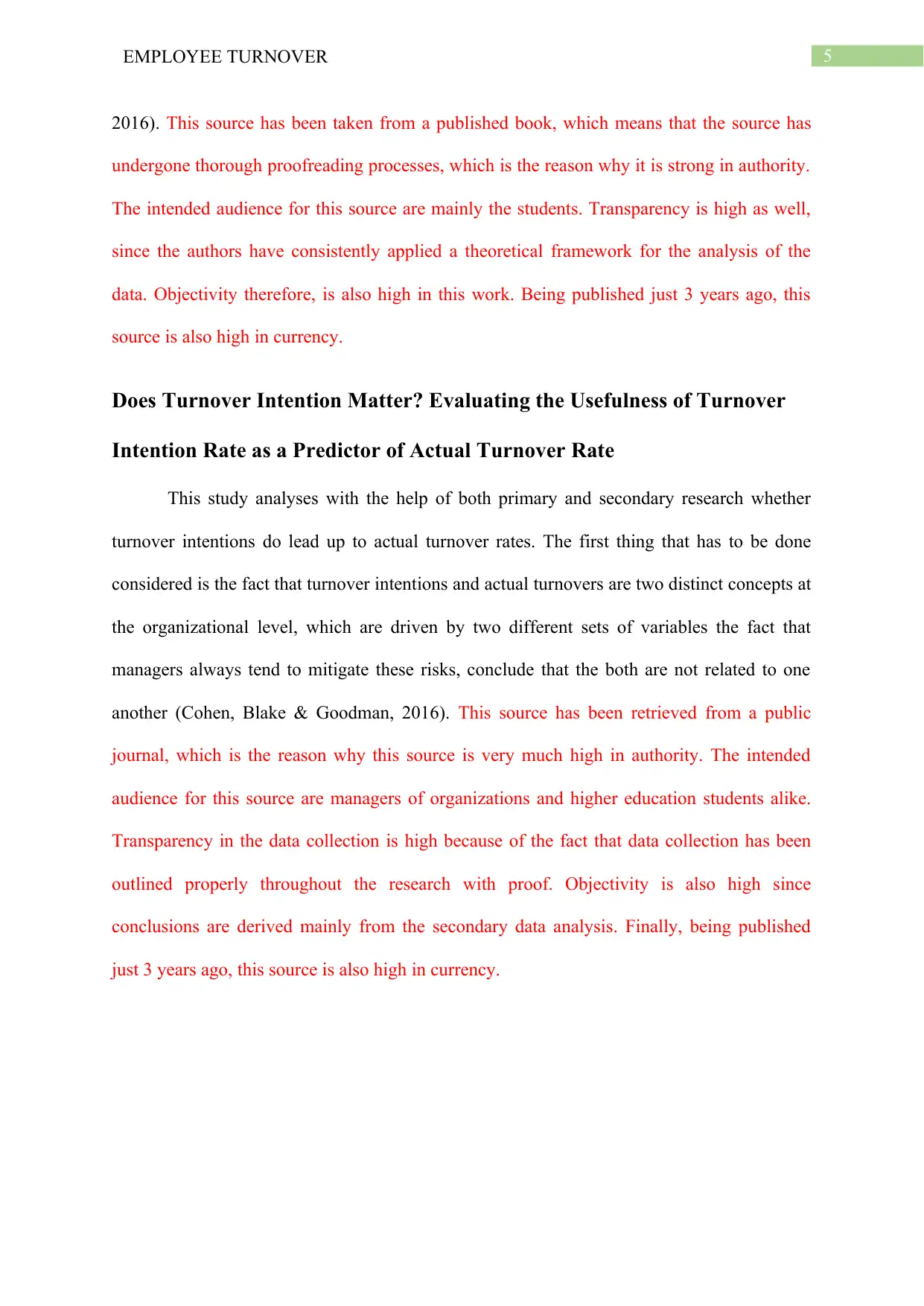
5EMPLOYEE TURNOVER
2016). This source has been taken from a published book, which means that the source has
undergone thorough proofreading processes, which is the reason why it is strong in authority.
The intended audience for this source are mainly the students. Transparency is high as well,
since the authors have consistently applied a theoretical framework for the analysis of the
data. Objectivity therefore, is also high in this work. Being published just 3 years ago, this
source is also high in currency.
Does Turnover Intention Matter? Evaluating the Usefulness of Turnover
Intention Rate as a Predictor of Actual Turnover Rate
This study analyses with the help of both primary and secondary research whether
turnover intentions do lead up to actual turnover rates. The first thing that has to be done
considered is the fact that turnover intentions and actual turnovers are two distinct concepts at
the organizational level, which are driven by two different sets of variables the fact that
managers always tend to mitigate these risks, conclude that the both are not related to one
another (Cohen, Blake & Goodman, 2016). This source has been retrieved from a public
journal, which is the reason why this source is very much high in authority. The intended
audience for this source are managers of organizations and higher education students alike.
Transparency in the data collection is high because of the fact that data collection has been
outlined properly throughout the research with proof. Objectivity is also high since
conclusions are derived mainly from the secondary data analysis. Finally, being published
just 3 years ago, this source is also high in currency.
2016). This source has been taken from a published book, which means that the source has
undergone thorough proofreading processes, which is the reason why it is strong in authority.
The intended audience for this source are mainly the students. Transparency is high as well,
since the authors have consistently applied a theoretical framework for the analysis of the
data. Objectivity therefore, is also high in this work. Being published just 3 years ago, this
source is also high in currency.
Does Turnover Intention Matter? Evaluating the Usefulness of Turnover
Intention Rate as a Predictor of Actual Turnover Rate
This study analyses with the help of both primary and secondary research whether
turnover intentions do lead up to actual turnover rates. The first thing that has to be done
considered is the fact that turnover intentions and actual turnovers are two distinct concepts at
the organizational level, which are driven by two different sets of variables the fact that
managers always tend to mitigate these risks, conclude that the both are not related to one
another (Cohen, Blake & Goodman, 2016). This source has been retrieved from a public
journal, which is the reason why this source is very much high in authority. The intended
audience for this source are managers of organizations and higher education students alike.
Transparency in the data collection is high because of the fact that data collection has been
outlined properly throughout the research with proof. Objectivity is also high since
conclusions are derived mainly from the secondary data analysis. Finally, being published
just 3 years ago, this source is also high in currency.
⊘ This is a preview!⊘
Do you want full access?
Subscribe today to unlock all pages.

Trusted by 1+ million students worldwide

6EMPLOYEE TURNOVER
Does Pay‐for‐Performance Strain the Employment Relationship? The
Effect of Manager Bonus Eligibility on Nonmanagement Employee
Turnover?
This study takes agency theory and equity theory as the two main theories as the
theoretical framework for this study. It assesses whether pay for performance policies affect
employee relations. The study finds out that employee relations depend a lot on employee
equity and the traditional PFP policy does lead employee discontent and turnover (Pohler &
Schmidt, 2016). This source has not been taken from a very popular academic journal, which
questions the authority of the source. It has also been observed that the main intended
audience for this paper involve higher education students. Transparency in data collection is
unclear and therefore, it also questions the objectivity of the source. However, being
published within the last 3 years, the currency of this source is high.
Does Pay‐for‐Performance Strain the Employment Relationship? The
Effect of Manager Bonus Eligibility on Nonmanagement Employee
Turnover?
This study takes agency theory and equity theory as the two main theories as the
theoretical framework for this study. It assesses whether pay for performance policies affect
employee relations. The study finds out that employee relations depend a lot on employee
equity and the traditional PFP policy does lead employee discontent and turnover (Pohler &
Schmidt, 2016). This source has not been taken from a very popular academic journal, which
questions the authority of the source. It has also been observed that the main intended
audience for this paper involve higher education students. Transparency in data collection is
unclear and therefore, it also questions the objectivity of the source. However, being
published within the last 3 years, the currency of this source is high.
Paraphrase This Document
Need a fresh take? Get an instant paraphrase of this document with our AI Paraphraser

7EMPLOYEE TURNOVER
References
Cohen, G., Blake, R. S., & Goodman, D. (2016). Does turnover intention matter? Evaluating
the usefulness of turnover intention rate as a predictor of actual turnover rate. Review
of Public Personnel Administration, 36(3), 240-263.
Ertas, N. (2015). Turnover intentions and work motivations of millennial employees in
federal service. Public Personnel Management, 44(3), 401-423.
Glebbeek, A. C., & Bax, E. H. (2004). Is high employee turnover really harmful? An
empirical test using company records. Academy of Management Journal, 47(2), 277-
286.
Guthrie, J. P. (2001). High-involvement work practices, turnover, and productivity: Evidence
from New Zealand. Academy of management Journal, 44(1), 180-190.
Huang, Y. H., Lee, J., McFadden, A. C., Murphy, L. A., Robertson, M. M., Cheung, J. H., &
Zohar, D. (2016). Beyond safety outcomes: An investigation of the impact of safety
climate on job satisfaction, employee engagement and turnover using social exchange
theory as the theoretical framework. Applied ergonomics, 55, 248-257.
Kichuk, A., Brown, L., & Ladkin, A. (2019). Talent pool exclusion: the hotel employee
perspective. International Journal of Contemporary Hospitality Management.
Lin, C. P. (2017). Modeling corporate citizenship and turnover intention: social identity and
expectancy theories. Review of Managerial Science, 1-18.
Peltokorpi, V., Allen, D. G., & Froese, F. (2015). Organizational embeddedness, turnover
intentions, and voluntary turnover: The moderating effects of employee demographic
characteristics and value orientations. Journal of Organizational Behavior, 36(2),
292-312.
References
Cohen, G., Blake, R. S., & Goodman, D. (2016). Does turnover intention matter? Evaluating
the usefulness of turnover intention rate as a predictor of actual turnover rate. Review
of Public Personnel Administration, 36(3), 240-263.
Ertas, N. (2015). Turnover intentions and work motivations of millennial employees in
federal service. Public Personnel Management, 44(3), 401-423.
Glebbeek, A. C., & Bax, E. H. (2004). Is high employee turnover really harmful? An
empirical test using company records. Academy of Management Journal, 47(2), 277-
286.
Guthrie, J. P. (2001). High-involvement work practices, turnover, and productivity: Evidence
from New Zealand. Academy of management Journal, 44(1), 180-190.
Huang, Y. H., Lee, J., McFadden, A. C., Murphy, L. A., Robertson, M. M., Cheung, J. H., &
Zohar, D. (2016). Beyond safety outcomes: An investigation of the impact of safety
climate on job satisfaction, employee engagement and turnover using social exchange
theory as the theoretical framework. Applied ergonomics, 55, 248-257.
Kichuk, A., Brown, L., & Ladkin, A. (2019). Talent pool exclusion: the hotel employee
perspective. International Journal of Contemporary Hospitality Management.
Lin, C. P. (2017). Modeling corporate citizenship and turnover intention: social identity and
expectancy theories. Review of Managerial Science, 1-18.
Peltokorpi, V., Allen, D. G., & Froese, F. (2015). Organizational embeddedness, turnover
intentions, and voluntary turnover: The moderating effects of employee demographic
characteristics and value orientations. Journal of Organizational Behavior, 36(2),
292-312.
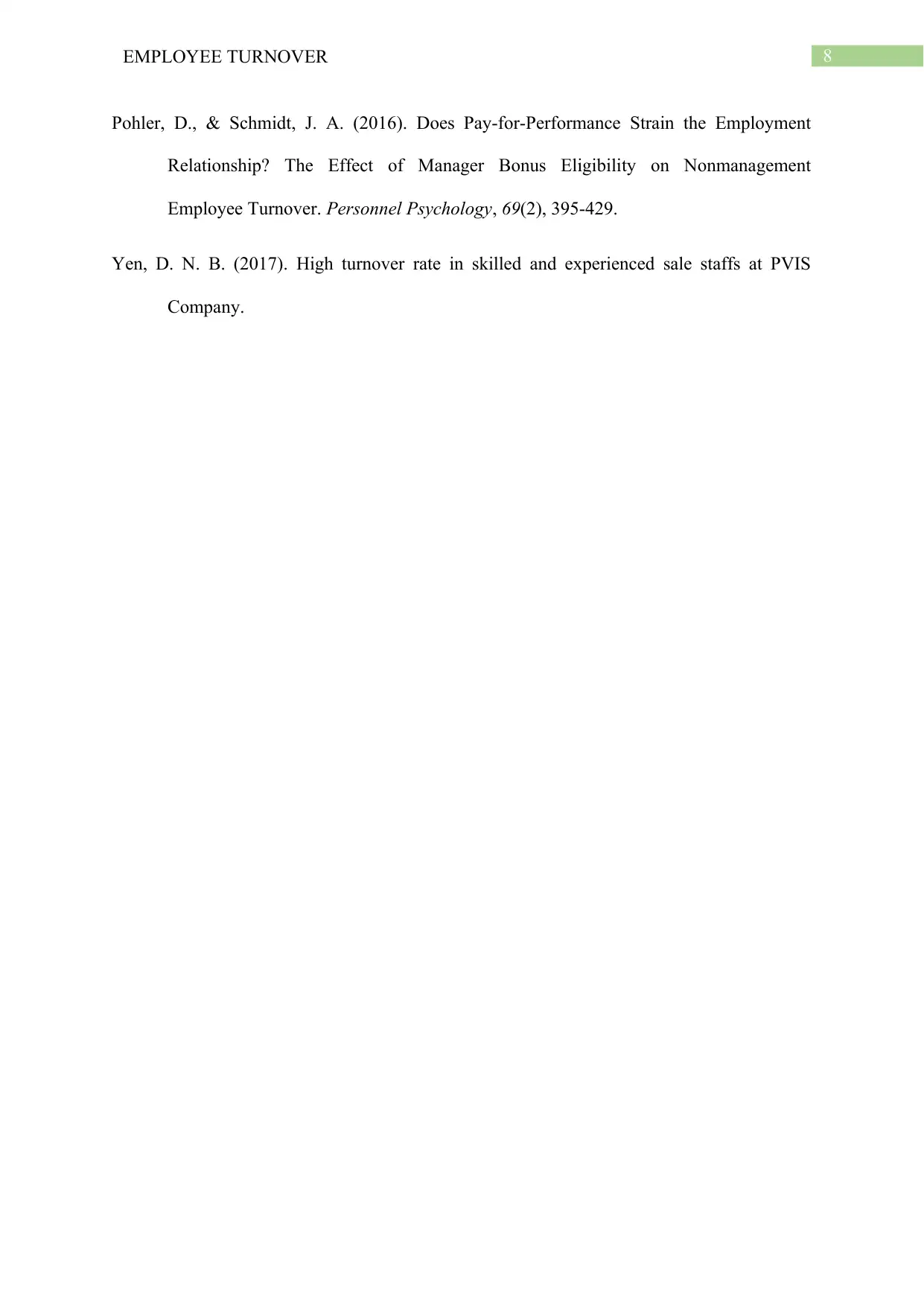
8EMPLOYEE TURNOVER
Pohler, D., & Schmidt, J. A. (2016). Does Pay‐for‐Performance Strain the Employment
Relationship? The Effect of Manager Bonus Eligibility on Nonmanagement
Employee Turnover. Personnel Psychology, 69(2), 395-429.
Yen, D. N. B. (2017). High turnover rate in skilled and experienced sale staffs at PVIS
Company.
Pohler, D., & Schmidt, J. A. (2016). Does Pay‐for‐Performance Strain the Employment
Relationship? The Effect of Manager Bonus Eligibility on Nonmanagement
Employee Turnover. Personnel Psychology, 69(2), 395-429.
Yen, D. N. B. (2017). High turnover rate in skilled and experienced sale staffs at PVIS
Company.
⊘ This is a preview!⊘
Do you want full access?
Subscribe today to unlock all pages.

Trusted by 1+ million students worldwide
1 out of 9
Related Documents
Your All-in-One AI-Powered Toolkit for Academic Success.
+13062052269
info@desklib.com
Available 24*7 on WhatsApp / Email
![[object Object]](/_next/static/media/star-bottom.7253800d.svg)
Unlock your academic potential
Copyright © 2020–2025 A2Z Services. All Rights Reserved. Developed and managed by ZUCOL.




